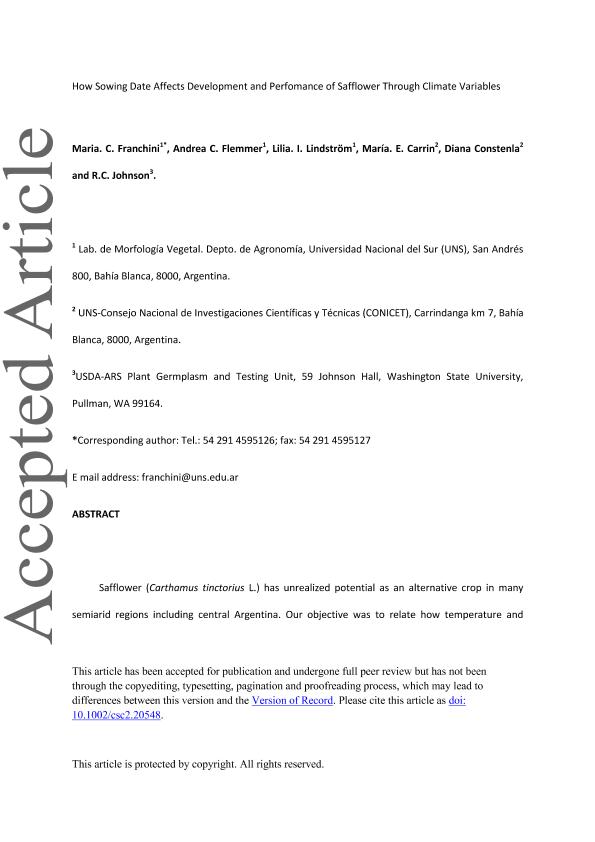Artículo
How sowing date affects development and performance of safflower through climate variables
Franchini, María Clara; Flemmer, Andrea Cecilia; Lindström, Lilia Ivone; Carrin, Maria Elena ; Constenla, Diana Teresita
; Constenla, Diana Teresita ; Johnson, Richard Coburn
; Johnson, Richard Coburn
 ; Constenla, Diana Teresita
; Constenla, Diana Teresita ; Johnson, Richard Coburn
; Johnson, Richard Coburn
Fecha de publicación:
15/06/2021
Editorial:
Crop Science Society of America
Revista:
Crop Science
ISSN:
0011-183X
Idioma:
Inglés
Tipo de recurso:
Artículo publicado
Clasificación temática:
Resumen
Safflower (Carthamus tinctorius L.) has unrealized potential as an alternative crop in many semiarid regions including central Argentina. Our objective was to relate how temperature and precipitation conditions with fall (5 June 2012 and 23 Apr. 2013) and winter sowing (13 Aug. 2012 and 20 Aug. 2013) affected phenology, yield, yield components, and oil percent in four winter and eight spring-type safflower accessions in the semiarid region of central Argentina. Fall sowing was associated with lower temperatures, higher precipitation, lower heat/moisture stress indices and precipitation deficits than winter sowing. Rosette period lasted 55 d longer, and stem elongation to anthesis period 30 d longer in fall than in winter sowing. However, anthesis was advanced only few days in fall sowing and duration of postanthesis development was comparable between sowing regimes and years. Fall sowing plants averaged 3,252 filled grains m–2 and a grain yield of 109.8 g m–2, whereas winter sowing plants averaged 1,443 filled grains m–2 and a grain yield of 49.3 g m–2. Grain yield was 35% higher in winter than in spring-type accessions, but winter types had lower oil percent (22.0%) than spring-types (33.3%). In the semiarid region of central Argentina, we recommend fall sowing as it extended the growing season in terms of days preanthesis and presented favorable climatic conditions for safflower development.
Palabras clave:
SAFFLOWER
,
CLIMATE CONDITIONS
,
CROP DEVELOPMENT
Archivos asociados
Licencia
Identificadores
Colecciones
Articulos(PLAPIQUI)
Articulos de PLANTA PILOTO DE INGENIERIA QUIMICA (I)
Articulos de PLANTA PILOTO DE INGENIERIA QUIMICA (I)
Citación
Franchini, María Clara; Flemmer, Andrea Cecilia; Lindström, Lilia Ivone; Carrin, Maria Elena; Constenla, Diana Teresita; et al.; How sowing date affects development and performance of safflower through climate variables; Crop Science Society of America; Crop Science; 61; 4; 15-6-2021; 2775-2786
Compartir
Altmétricas



